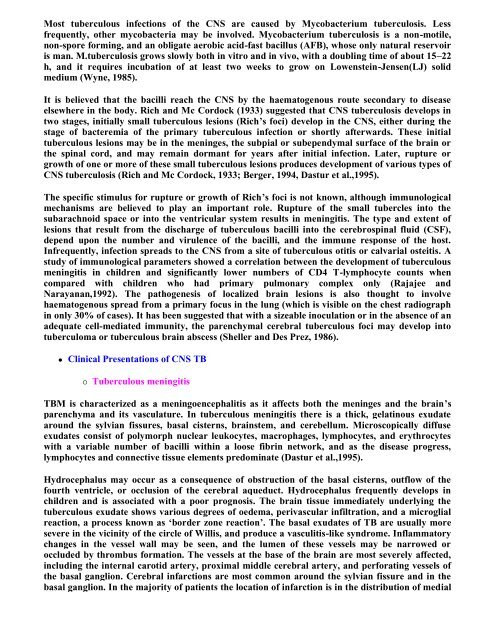INTRODUCTION Granulomatous inflammation is a distinctive ...
INTRODUCTION Granulomatous inflammation is a distinctive ...
INTRODUCTION Granulomatous inflammation is a distinctive ...
You also want an ePaper? Increase the reach of your titles
YUMPU automatically turns print PDFs into web optimized ePapers that Google loves.
Most tuberculous infections of the CNS are caused by Mycobacterium tuberculos<strong>is</strong>. Less<br />
frequently, other mycobacteria may be involved. Mycobacterium tuberculos<strong>is</strong> <strong>is</strong> a non-motile,<br />
non-spore forming, and an obligate aerobic acid-fast bacillus (AFB), whose only natural reservoir<br />
<strong>is</strong> man. M.tuberculos<strong>is</strong> grows slowly both in vitro and in vivo, with a doubling time of about 15–22<br />
h, and it requires incubation of at least two weeks to grow on Lowenstein-Jensen(LJ) solid<br />
medium (Wyne, 1985).<br />
It <strong>is</strong> believed that the bacilli reach the CNS by the haematogenous route secondary to d<strong>is</strong>ease<br />
elsewhere in the body. Rich and Mc Cordock (1933) suggested that CNS tuberculos<strong>is</strong> develops in<br />
two stages, initially small tuberculous lesions (Rich’s foci) develop in the CNS, either during the<br />
stage of bacteremia of the primary tuberculous infection or shortly afterwards. These initial<br />
tuberculous lesions may be in the meninges, the subpial or subependymal surface of the brain or<br />
the spinal cord, and may remain dormant for years after initial infection. Later, rupture or<br />
growth of one or more of these small tuberculous lesions produces development of various types of<br />
CNS tuberculos<strong>is</strong> (Rich and Mc Cordock, 1933; Berger, 1994, Dastur et al.,1995).<br />
The specific stimulus for rupture or growth of Rich’s foci <strong>is</strong> not known, although immunological<br />
mechan<strong>is</strong>ms are believed to play an important role. Rupture of the small tubercles into the<br />
subarachnoid space or into the ventricular system results in meningit<strong>is</strong>. The type and extent of<br />
lesions that result from the d<strong>is</strong>charge of tuberculous bacilli into the cerebrospinal fluid (CSF),<br />
depend upon the number and virulence of the bacilli, and the immune response of the host.<br />
Infrequently, infection spreads to the CNS from a site of tuberculous otit<strong>is</strong> or calvarial osteit<strong>is</strong>. A<br />
study of immunological parameters showed a correlation between the development of tuberculous<br />
meningit<strong>is</strong> in children and significantly lower numbers of CD4 T-lymphocyte counts when<br />
compared with children who had primary pulmonary complex only (Rajajee and<br />
Narayanan,1992). The pathogenes<strong>is</strong> of localized brain lesions <strong>is</strong> also thought to involve<br />
haematogenous spread from a primary focus in the lung (which <strong>is</strong> v<strong>is</strong>ible on the chest radiograph<br />
in only 30% of cases). It has been suggested that with a sizeable inoculation or in the absence of an<br />
adequate cell-mediated immunity, the parenchymal cerebral tuberculous foci may develop into<br />
tuberculoma or tuberculous brain abscess (Sheller and Des Prez, 1986).<br />
Clinical Presentations of CNS TB<br />
Tuberculous meningit<strong>is</strong><br />
TBM <strong>is</strong> characterized as a meningoencephalit<strong>is</strong> as it affects both the meninges and the brain’s<br />
parenchyma and its vasculature. In tuberculous meningit<strong>is</strong> there <strong>is</strong> a thick, gelatinous exudate<br />
around the sylvian f<strong>is</strong>sures, basal c<strong>is</strong>terns, brainstem, and cerebellum. Microscopically diffuse<br />
exudates cons<strong>is</strong>t of polymorph nuclear leukocytes, macrophages, lymphocytes, and erythrocytes<br />
with a variable number of bacilli within a loose fibrin network, and as the d<strong>is</strong>ease progress,<br />
lymphocytes and connective t<strong>is</strong>sue elements predominate (Dastur et al.,1995).<br />
Hydrocephalus may occur as a consequence of obstruction of the basal c<strong>is</strong>terns, outflow of the<br />
fourth ventricle, or occlusion of the cerebral aqueduct. Hydrocephalus frequently develops in<br />
children and <strong>is</strong> associated with a poor prognos<strong>is</strong>. The brain t<strong>is</strong>sue immediately underlying the<br />
tuberculous exudate shows various degrees of oedema, perivascular infiltration, and a microglial<br />
reaction, a process known as ‘border zone reaction’. The basal exudates of TB are usually more<br />
severe in the vicinity of the circle of Will<strong>is</strong>, and produce a vasculit<strong>is</strong>-like syndrome. Inflammatory<br />
changes in the vessel wall may be seen, and the lumen of these vessels may be narrowed or<br />
occluded by thrombus formation. The vessels at the base of the brain are most severely affected,<br />
including the internal carotid artery, proximal middle cerebral artery, and perforating vessels of<br />
the basal ganglion. Cerebral infarctions are most common around the sylvian f<strong>is</strong>sure and in the<br />
basal ganglion. In the majority of patients the location of infarction <strong>is</strong> in the d<strong>is</strong>tribution of medial


